HIV/AIDS and Psychological Distress
VerifiedAdded on 2019/09/30
|7
|2829
|228
Literature Review
AI Summary
This literature review critically examines existing research on the psychological consequences of HIV/AIDS, focusing on anxiety, depression, and emotional distress. It analyzes various studies, highlighting their methodologies, findings, and limitations. The review identifies gaps in the literature, such as the lack of detailed investigation into the mechanisms underlying these psychological disorders and the limited use of validated diagnostic tools. The studies reviewed often focus on the effectiveness of medication in managing AIDS but neglect the crucial aspect of addressing the emotional and psychological well-being of patients. Socioeconomic factors and their influence on mental health outcomes in HIV-positive individuals are also discussed. The review concludes by emphasizing the need for further research to address these gaps and develop comprehensive interventions that consider both the physical and mental health needs of individuals affected by HIV/AIDS.
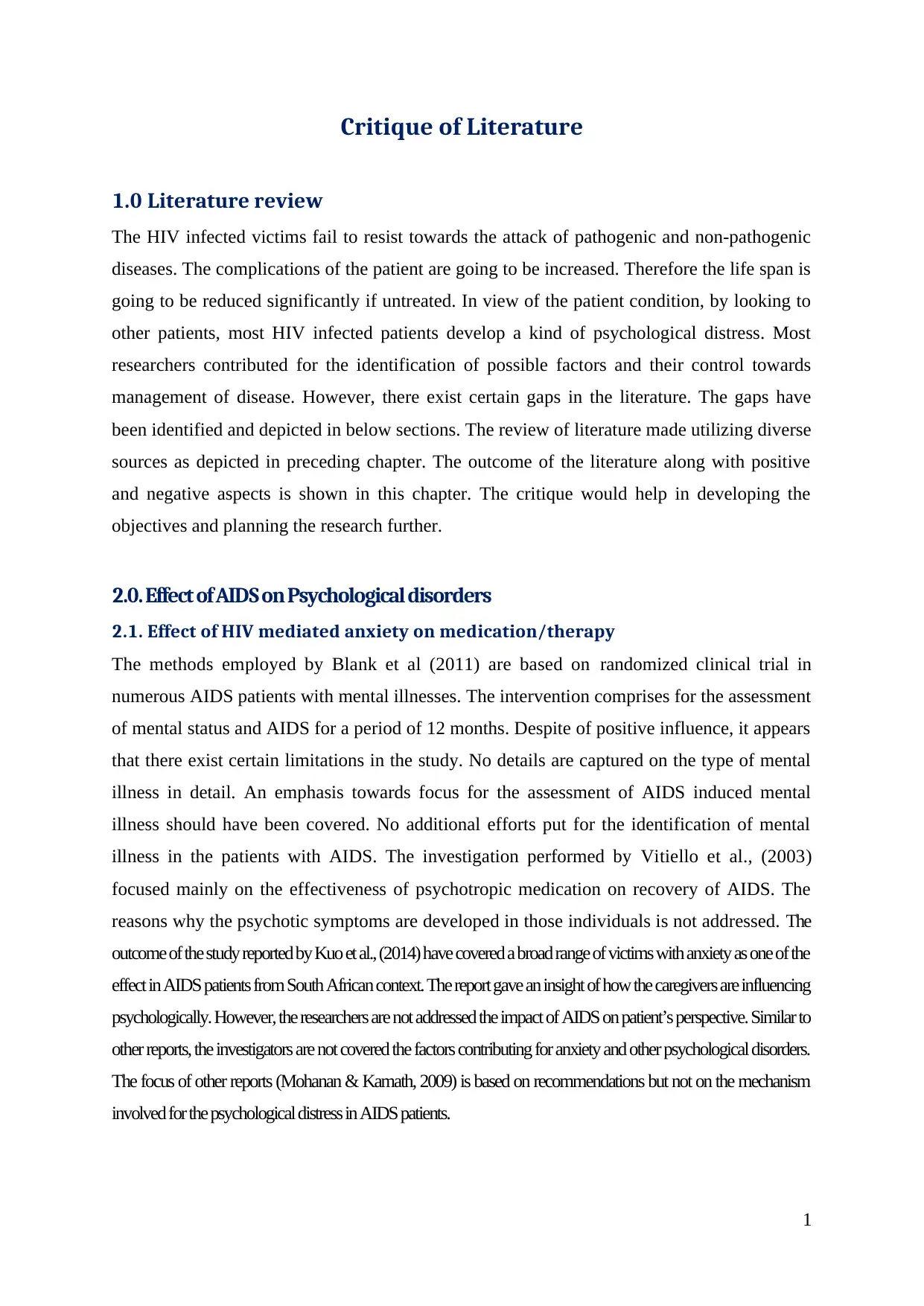
Critique of Literature
1.0 Literature review
The HIV infected victims fail to resist towards the attack of pathogenic and non-pathogenic
diseases. The complications of the patient are going to be increased. Therefore the life span is
going to be reduced significantly if untreated. In view of the patient condition, by looking to
other patients, most HIV infected patients develop a kind of psychological distress. Most
researchers contributed for the identification of possible factors and their control towards
management of disease. However, there exist certain gaps in the literature. The gaps have
been identified and depicted in below sections. The review of literature made utilizing diverse
sources as depicted in preceding chapter. The outcome of the literature along with positive
and negative aspects is shown in this chapter. The critique would help in developing the
objectives and planning the research further.
2.0. Effect of AIDS on Psychological disorders
2.1. Effect of HIV mediated anxiety on medication/therapy
The methods employed by Blank et al (2011) are based on randomized clinical trial in
numerous AIDS patients with mental illnesses. The intervention comprises for the assessment
of mental status and AIDS for a period of 12 months. Despite of positive influence, it appears
that there exist certain limitations in the study. No details are captured on the type of mental
illness in detail. An emphasis towards focus for the assessment of AIDS induced mental
illness should have been covered. No additional efforts put for the identification of mental
illness in the patients with AIDS. The investigation performed by Vitiello et al., (2003)
focused mainly on the effectiveness of psychotropic medication on recovery of AIDS. The
reasons why the psychotic symptoms are developed in those individuals is not addressed. The
outcome of the study reported by Kuo et al., (2014) have covered a broad range of victims with anxiety as one of the
effect in AIDS patients from South African context. The report gave an insight of how the caregivers are influencing
psychologically. However, the researchers are not addressed the impact of AIDS on patient’s perspective. Similar to
other reports, the investigators are not covered the factors contributing for anxiety and other psychological disorders.
The focus of other reports (Mohanan & Kamath, 2009) is based on recommendations but not on the mechanism
involved for the psychological distress in AIDS patients.
1
1.0 Literature review
The HIV infected victims fail to resist towards the attack of pathogenic and non-pathogenic
diseases. The complications of the patient are going to be increased. Therefore the life span is
going to be reduced significantly if untreated. In view of the patient condition, by looking to
other patients, most HIV infected patients develop a kind of psychological distress. Most
researchers contributed for the identification of possible factors and their control towards
management of disease. However, there exist certain gaps in the literature. The gaps have
been identified and depicted in below sections. The review of literature made utilizing diverse
sources as depicted in preceding chapter. The outcome of the literature along with positive
and negative aspects is shown in this chapter. The critique would help in developing the
objectives and planning the research further.
2.0. Effect of AIDS on Psychological disorders
2.1. Effect of HIV mediated anxiety on medication/therapy
The methods employed by Blank et al (2011) are based on randomized clinical trial in
numerous AIDS patients with mental illnesses. The intervention comprises for the assessment
of mental status and AIDS for a period of 12 months. Despite of positive influence, it appears
that there exist certain limitations in the study. No details are captured on the type of mental
illness in detail. An emphasis towards focus for the assessment of AIDS induced mental
illness should have been covered. No additional efforts put for the identification of mental
illness in the patients with AIDS. The investigation performed by Vitiello et al., (2003)
focused mainly on the effectiveness of psychotropic medication on recovery of AIDS. The
reasons why the psychotic symptoms are developed in those individuals is not addressed. The
outcome of the study reported by Kuo et al., (2014) have covered a broad range of victims with anxiety as one of the
effect in AIDS patients from South African context. The report gave an insight of how the caregivers are influencing
psychologically. However, the researchers are not addressed the impact of AIDS on patient’s perspective. Similar to
other reports, the investigators are not covered the factors contributing for anxiety and other psychological disorders.
The focus of other reports (Mohanan & Kamath, 2009) is based on recommendations but not on the mechanism
involved for the psychological distress in AIDS patients.
1
Paraphrase This Document
Need a fresh take? Get an instant paraphrase of this document with our AI Paraphraser

2.2. Effect of HIV mediated depression on medication/therapy
Antidepressant efficacy in HIV care have been evaluated by Pence et al., (2015), did not bring a significant
improvement in HIV outcome despite of following adequate assessment and statistics. The investigators evaluated
the adherence of antiretroviral therapy and depression morbidity. Except depression, no other psychological diseases
been covered in the investigation. The study was also pseudo cluster randomization, a design most suits for in
smaller number of study participants (Melis et al., 2011). The sample size included is reasonably good
however, the investigators employed pseudo cluster randomization.
Mitzel et al., (2015) tested the role of depressive symptoms on adherence of anti HIV-medication adherence. The
study was based on homosexual patients (66 HIV-infected men who have sex with men) in an outpatient infectious
disease clinic. The investigation did not reveal about the types of design employed however the outcome showed a
significant impact in terms of stigma-related experiences. It was positive with depressive symptoms and negative
towards adherence. Similar to preceding outcomes and methods, the investigators did not covered other
psychological disorders. Turan et al., (2015) attempted to fill the gap of the research between
internalized stigma and anti retroviral therapy. The investigation was carried in more than 1000 women patients.
The researchers used an old method for the assessment of depression and are on grading. Novel methods such as
Preguntas con Cartas (Caplan, 2016) should have been used to avoid the bias of the old method. The study
was based on multicenter however inter comparisons of the study was missing. In addition, the aspects of emotion
and anxiety are not covered. A cross-sectional study (Medha et al., 2011) based on southeastern United States
covered the relationship between social bolster, HIV exposure, and melancholy. A part from the dermatographic
data, the investigators (Medha et al., 2011) investigated the effect of independent variables (nine-item scale with a 3-
point Likert-type) on dependent variables, depression. The relationship between independent and dependent
variables is missing. However, the outcome reveals that the rural women from southeastern United States are often
under-diagnosed and inadequately treated for depression. No details are captured from emotion and other
psychological disorders
2.3. Effect of HIV/AIDS on emotion
In absence of adequate preventive measures before diagnosing the HIV infection, the individuals can
survive for the couple of years. Once the disease is diagnosed for the AIDS, individuals can undergo
emotional distress leading to significant reduction of life span. Okulicz et al., (2009) reported the
role of viral load on the reduction of victim immunity however, why and how the individual is
undergoing for emotional distress is not explained. The link between the ‘suppression of immunity’
and its repercussions on emotions is missing. To prolong life, investigators (Mocroft et al., 2002)
recommended using either single or multiple regimens from novel source for the mitigation
of diseases. The study was conducted in about numerous patients and found that the
2
Antidepressant efficacy in HIV care have been evaluated by Pence et al., (2015), did not bring a significant
improvement in HIV outcome despite of following adequate assessment and statistics. The investigators evaluated
the adherence of antiretroviral therapy and depression morbidity. Except depression, no other psychological diseases
been covered in the investigation. The study was also pseudo cluster randomization, a design most suits for in
smaller number of study participants (Melis et al., 2011). The sample size included is reasonably good
however, the investigators employed pseudo cluster randomization.
Mitzel et al., (2015) tested the role of depressive symptoms on adherence of anti HIV-medication adherence. The
study was based on homosexual patients (66 HIV-infected men who have sex with men) in an outpatient infectious
disease clinic. The investigation did not reveal about the types of design employed however the outcome showed a
significant impact in terms of stigma-related experiences. It was positive with depressive symptoms and negative
towards adherence. Similar to preceding outcomes and methods, the investigators did not covered other
psychological disorders. Turan et al., (2015) attempted to fill the gap of the research between
internalized stigma and anti retroviral therapy. The investigation was carried in more than 1000 women patients.
The researchers used an old method for the assessment of depression and are on grading. Novel methods such as
Preguntas con Cartas (Caplan, 2016) should have been used to avoid the bias of the old method. The study
was based on multicenter however inter comparisons of the study was missing. In addition, the aspects of emotion
and anxiety are not covered. A cross-sectional study (Medha et al., 2011) based on southeastern United States
covered the relationship between social bolster, HIV exposure, and melancholy. A part from the dermatographic
data, the investigators (Medha et al., 2011) investigated the effect of independent variables (nine-item scale with a 3-
point Likert-type) on dependent variables, depression. The relationship between independent and dependent
variables is missing. However, the outcome reveals that the rural women from southeastern United States are often
under-diagnosed and inadequately treated for depression. No details are captured from emotion and other
psychological disorders
2.3. Effect of HIV/AIDS on emotion
In absence of adequate preventive measures before diagnosing the HIV infection, the individuals can
survive for the couple of years. Once the disease is diagnosed for the AIDS, individuals can undergo
emotional distress leading to significant reduction of life span. Okulicz et al., (2009) reported the
role of viral load on the reduction of victim immunity however, why and how the individual is
undergoing for emotional distress is not explained. The link between the ‘suppression of immunity’
and its repercussions on emotions is missing. To prolong life, investigators (Mocroft et al., 2002)
recommended using either single or multiple regimens from novel source for the mitigation
of diseases. The study was conducted in about numerous patients and found that the
2
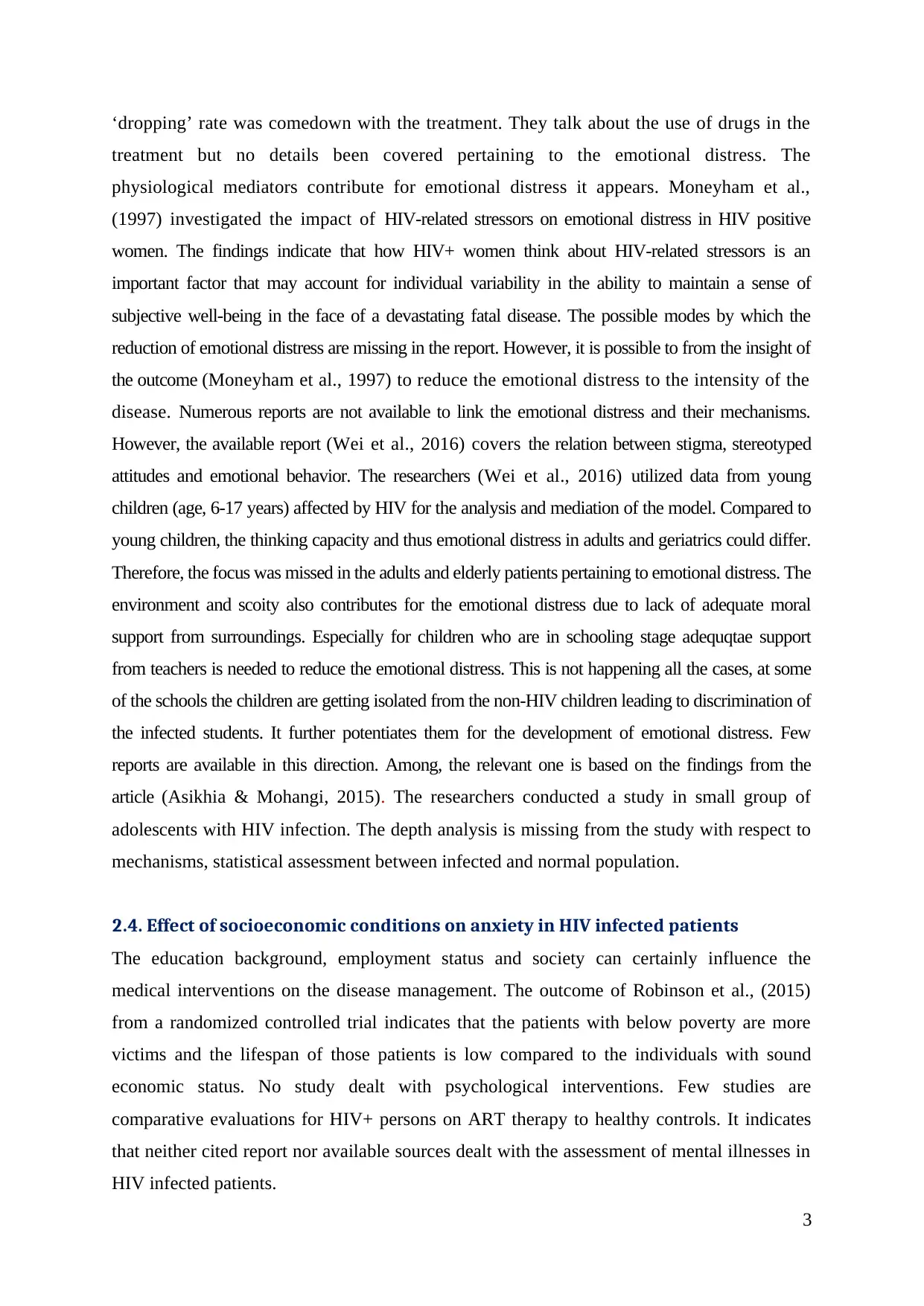
‘dropping’ rate was comedown with the treatment. They talk about the use of drugs in the
treatment but no details been covered pertaining to the emotional distress. The
physiological mediators contribute for emotional distress it appears. Moneyham et al.,
(1997) investigated the impact of HIV-related stressors on emotional distress in HIV positive
women. The findings indicate that how HIV+ women think about HIV-related stressors is an
important factor that may account for individual variability in the ability to maintain a sense of
subjective well-being in the face of a devastating fatal disease. The possible modes by which the
reduction of emotional distress are missing in the report. However, it is possible to from the insight of
the outcome (Moneyham et al., 1997) to reduce the emotional distress to the intensity of the
disease. Numerous reports are not available to link the emotional distress and their mechanisms.
However, the available report (Wei et al., 2016) covers the relation between stigma, stereotyped
attitudes and emotional behavior. The researchers (Wei et al., 2016) utilized data from young
children (age, 6-17 years) affected by HIV for the analysis and mediation of the model. Compared to
young children, the thinking capacity and thus emotional distress in adults and geriatrics could differ.
Therefore, the focus was missed in the adults and elderly patients pertaining to emotional distress. The
environment and scoity also contributes for the emotional distress due to lack of adequate moral
support from surroundings. Especially for children who are in schooling stage adequqtae support
from teachers is needed to reduce the emotional distress. This is not happening all the cases, at some
of the schools the children are getting isolated from the non-HIV children leading to discrimination of
the infected students. It further potentiates them for the development of emotional distress. Few
reports are available in this direction. Among, the relevant one is based on the findings from the
article (Asikhia & Mohangi, 2015). The researchers conducted a study in small group of
adolescents with HIV infection. The depth analysis is missing from the study with respect to
mechanisms, statistical assessment between infected and normal population.
2.4. Effect of socioeconomic conditions on anxiety in HIV infected patients
The education background, employment status and society can certainly influence the
medical interventions on the disease management. The outcome of Robinson et al., (2015)
from a randomized controlled trial indicates that the patients with below poverty are more
victims and the lifespan of those patients is low compared to the individuals with sound
economic status. No study dealt with psychological interventions. Few studies are
comparative evaluations for HIV+ persons on ART therapy to healthy controls. It indicates
that neither cited report nor available sources dealt with the assessment of mental illnesses in
HIV infected patients.
3
treatment but no details been covered pertaining to the emotional distress. The
physiological mediators contribute for emotional distress it appears. Moneyham et al.,
(1997) investigated the impact of HIV-related stressors on emotional distress in HIV positive
women. The findings indicate that how HIV+ women think about HIV-related stressors is an
important factor that may account for individual variability in the ability to maintain a sense of
subjective well-being in the face of a devastating fatal disease. The possible modes by which the
reduction of emotional distress are missing in the report. However, it is possible to from the insight of
the outcome (Moneyham et al., 1997) to reduce the emotional distress to the intensity of the
disease. Numerous reports are not available to link the emotional distress and their mechanisms.
However, the available report (Wei et al., 2016) covers the relation between stigma, stereotyped
attitudes and emotional behavior. The researchers (Wei et al., 2016) utilized data from young
children (age, 6-17 years) affected by HIV for the analysis and mediation of the model. Compared to
young children, the thinking capacity and thus emotional distress in adults and geriatrics could differ.
Therefore, the focus was missed in the adults and elderly patients pertaining to emotional distress. The
environment and scoity also contributes for the emotional distress due to lack of adequate moral
support from surroundings. Especially for children who are in schooling stage adequqtae support
from teachers is needed to reduce the emotional distress. This is not happening all the cases, at some
of the schools the children are getting isolated from the non-HIV children leading to discrimination of
the infected students. It further potentiates them for the development of emotional distress. Few
reports are available in this direction. Among, the relevant one is based on the findings from the
article (Asikhia & Mohangi, 2015). The researchers conducted a study in small group of
adolescents with HIV infection. The depth analysis is missing from the study with respect to
mechanisms, statistical assessment between infected and normal population.
2.4. Effect of socioeconomic conditions on anxiety in HIV infected patients
The education background, employment status and society can certainly influence the
medical interventions on the disease management. The outcome of Robinson et al., (2015)
from a randomized controlled trial indicates that the patients with below poverty are more
victims and the lifespan of those patients is low compared to the individuals with sound
economic status. No study dealt with psychological interventions. Few studies are
comparative evaluations for HIV+ persons on ART therapy to healthy controls. It indicates
that neither cited report nor available sources dealt with the assessment of mental illnesses in
HIV infected patients.
3
⊘ This is a preview!⊘
Do you want full access?
Subscribe today to unlock all pages.

Trusted by 1+ million students worldwide
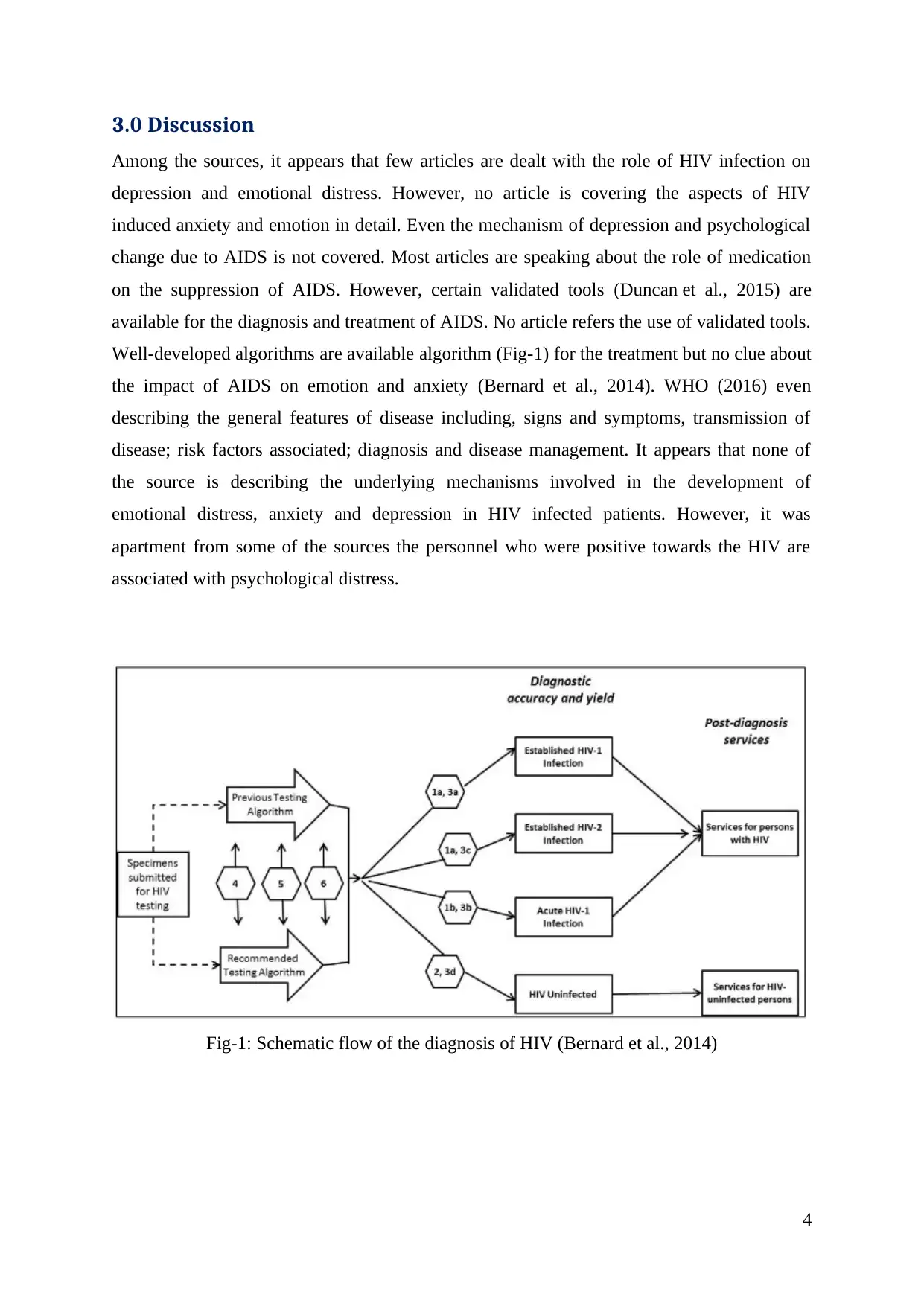
3.0 Discussion
Among the sources, it appears that few articles are dealt with the role of HIV infection on
depression and emotional distress. However, no article is covering the aspects of HIV
induced anxiety and emotion in detail. Even the mechanism of depression and psychological
change due to AIDS is not covered. Most articles are speaking about the role of medication
on the suppression of AIDS. However, certain validated tools (Duncan et al., 2015) are
available for the diagnosis and treatment of AIDS. No article refers the use of validated tools.
Well-developed algorithms are available algorithm (Fig-1) for the treatment but no clue about
the impact of AIDS on emotion and anxiety (Bernard et al., 2014). WHO (2016) even
describing the general features of disease including, signs and symptoms, transmission of
disease; risk factors associated; diagnosis and disease management. It appears that none of
the source is describing the underlying mechanisms involved in the development of
emotional distress, anxiety and depression in HIV infected patients. However, it was
apartment from some of the sources the personnel who were positive towards the HIV are
associated with psychological distress.
Fig-1: Schematic flow of the diagnosis of HIV (Bernard et al., 2014)
4
Among the sources, it appears that few articles are dealt with the role of HIV infection on
depression and emotional distress. However, no article is covering the aspects of HIV
induced anxiety and emotion in detail. Even the mechanism of depression and psychological
change due to AIDS is not covered. Most articles are speaking about the role of medication
on the suppression of AIDS. However, certain validated tools (Duncan et al., 2015) are
available for the diagnosis and treatment of AIDS. No article refers the use of validated tools.
Well-developed algorithms are available algorithm (Fig-1) for the treatment but no clue about
the impact of AIDS on emotion and anxiety (Bernard et al., 2014). WHO (2016) even
describing the general features of disease including, signs and symptoms, transmission of
disease; risk factors associated; diagnosis and disease management. It appears that none of
the source is describing the underlying mechanisms involved in the development of
emotional distress, anxiety and depression in HIV infected patients. However, it was
apartment from some of the sources the personnel who were positive towards the HIV are
associated with psychological distress.
Fig-1: Schematic flow of the diagnosis of HIV (Bernard et al., 2014)
4
Paraphrase This Document
Need a fresh take? Get an instant paraphrase of this document with our AI Paraphraser
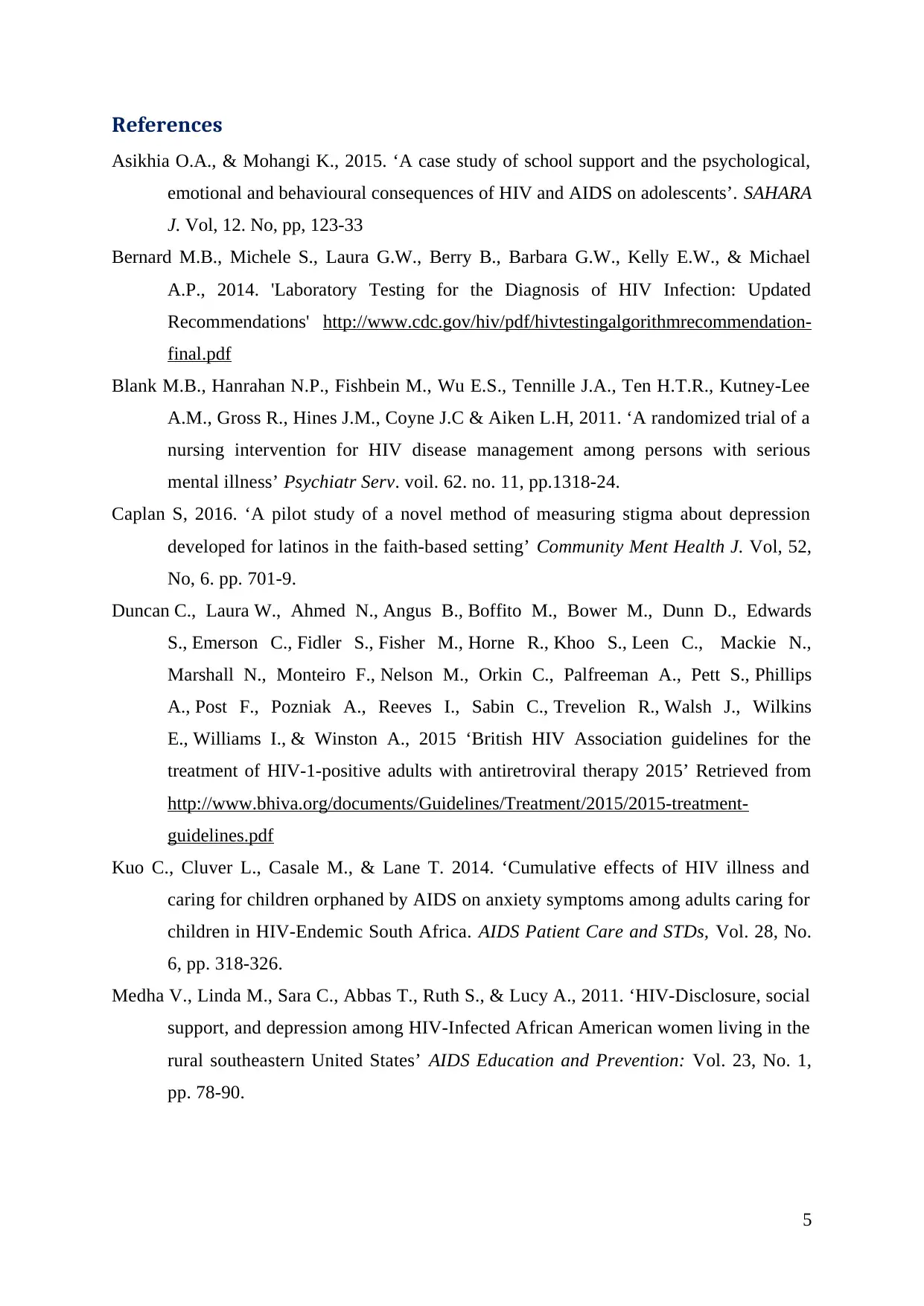
References
Asikhia O.A., & Mohangi K., 2015. ‘A case study of school support and the psychological,
emotional and behavioural consequences of HIV and AIDS on adolescents’. SAHARA
J. Vol, 12. No, pp, 123-33
Bernard M.B., Michele S., Laura G.W., Berry B., Barbara G.W., Kelly E.W., & Michael
A.P., 2014. 'Laboratory Testing for the Diagnosis of HIV Infection: Updated
Recommendations' http://www.cdc.gov/hiv/pdf/hivtestingalgorithmrecommendation-
final.pdf
Blank M.B., Hanrahan N.P., Fishbein M., Wu E.S., Tennille J.A., Ten H.T.R., Kutney-Lee
A.M., Gross R., Hines J.M., Coyne J.C & Aiken L.H, 2011. ‘A randomized trial of a
nursing intervention for HIV disease management among persons with serious
mental illness’ Psychiatr Serv. voil. 62. no. 11, pp.1318-24.
Caplan S, 2016. ‘A pilot study of a novel method of measuring stigma about depression
developed for latinos in the faith-based setting’ Community Ment Health J. Vol, 52,
No, 6. pp. 701-9.
Duncan C., Laura W., Ahmed N., Angus B., Boffito M., Bower M., Dunn D., Edwards
S., Emerson C., Fidler S., Fisher M., Horne R., Khoo S., Leen C., Mackie N.,
Marshall N., Monteiro F., Nelson M., Orkin C., Palfreeman A., Pett S., Phillips
A., Post F., Pozniak A., Reeves I., Sabin C., Trevelion R., Walsh J., Wilkins
E., Williams I., & Winston A., 2015 ‘British HIV Association guidelines for the
treatment of HIV-1-positive adults with antiretroviral therapy 2015’ Retrieved from
http://www.bhiva.org/documents/Guidelines/Treatment/2015/2015-treatment-
guidelines.pdf
Kuo C., Cluver L., Casale M., & Lane T. 2014. ‘Cumulative effects of HIV illness and
caring for children orphaned by AIDS on anxiety symptoms among adults caring for
children in HIV-Endemic South Africa. AIDS Patient Care and STDs, Vol. 28, No.
6, pp. 318-326.
Medha V., Linda M., Sara C., Abbas T., Ruth S., & Lucy A., 2011. ‘HIV-Disclosure, social
support, and depression among HIV-Infected African American women living in the
rural southeastern United States’ AIDS Education and Prevention: Vol. 23, No. 1,
pp. 78-90.
5
Asikhia O.A., & Mohangi K., 2015. ‘A case study of school support and the psychological,
emotional and behavioural consequences of HIV and AIDS on adolescents’. SAHARA
J. Vol, 12. No, pp, 123-33
Bernard M.B., Michele S., Laura G.W., Berry B., Barbara G.W., Kelly E.W., & Michael
A.P., 2014. 'Laboratory Testing for the Diagnosis of HIV Infection: Updated
Recommendations' http://www.cdc.gov/hiv/pdf/hivtestingalgorithmrecommendation-
final.pdf
Blank M.B., Hanrahan N.P., Fishbein M., Wu E.S., Tennille J.A., Ten H.T.R., Kutney-Lee
A.M., Gross R., Hines J.M., Coyne J.C & Aiken L.H, 2011. ‘A randomized trial of a
nursing intervention for HIV disease management among persons with serious
mental illness’ Psychiatr Serv. voil. 62. no. 11, pp.1318-24.
Caplan S, 2016. ‘A pilot study of a novel method of measuring stigma about depression
developed for latinos in the faith-based setting’ Community Ment Health J. Vol, 52,
No, 6. pp. 701-9.
Duncan C., Laura W., Ahmed N., Angus B., Boffito M., Bower M., Dunn D., Edwards
S., Emerson C., Fidler S., Fisher M., Horne R., Khoo S., Leen C., Mackie N.,
Marshall N., Monteiro F., Nelson M., Orkin C., Palfreeman A., Pett S., Phillips
A., Post F., Pozniak A., Reeves I., Sabin C., Trevelion R., Walsh J., Wilkins
E., Williams I., & Winston A., 2015 ‘British HIV Association guidelines for the
treatment of HIV-1-positive adults with antiretroviral therapy 2015’ Retrieved from
http://www.bhiva.org/documents/Guidelines/Treatment/2015/2015-treatment-
guidelines.pdf
Kuo C., Cluver L., Casale M., & Lane T. 2014. ‘Cumulative effects of HIV illness and
caring for children orphaned by AIDS on anxiety symptoms among adults caring for
children in HIV-Endemic South Africa. AIDS Patient Care and STDs, Vol. 28, No.
6, pp. 318-326.
Medha V., Linda M., Sara C., Abbas T., Ruth S., & Lucy A., 2011. ‘HIV-Disclosure, social
support, and depression among HIV-Infected African American women living in the
rural southeastern United States’ AIDS Education and Prevention: Vol. 23, No. 1,
pp. 78-90.
5

Melis R.J., Teerenstra S., Olde Rikkert M.G & Borm G.F, 2011. ‘Pseudo cluster
randomization: balancing the disadvantages of cluster and individual randomization’
Eval Health Prof. Vol 34, No, 2, pp. 151-63.
Mitzel L.D., Vanable P.A., Brown J.L., Bostwick R.A., Sweeney S.M., & Carey M.P., 2015. ‘Depressive
symptoms mediate the effect of HIV-related stigmatization on medication adherence among HIV-infected
men who have sex with men. AIDS Behav. Vol, 9. No, 8, pp. 1454-9.
Mocroft A., Brettle R., Kirk O., Blaxhult A., Parkin J.M., Antunes F., Francioli P.,
D'Arminio Monforte A., Fox Z & Lundgren J.D. 2002. ‘Changes in the cause of
death among HIV positive subjects across Europe: results from the EuroSIDA
study’. AIDS. Vol, 16. No, 12, pp. 1663-71.
Mohanan P., & Kamath A., 2009. 'Family support for reducing morbidity and mortality in people with HIV/AIDS'
Cochrane Database Syst Rev. Vol, 8. No, 3 :CD006046. doi: 10.1002/14651858.CD006046.pub2.
Moneyham L., Seals B., Sowell R., Hennessy M., Demi A., & Brake S., 1997. ‘The impact
of HIV on emotional distress of infected women: cognitive appraisal and coping as
mediators’. Sch Inq Nurs Pract. Vol, 11. No, 2, pp. 125-45
Okulicz J.F., Marconi V.C., Landrum M.L., Wegner S., Weintrob A., Ganesan A., Hale B.,
Crum-Cianflone N., Delmar J., Barthel V., Quinnan G., Agan B.K., & Dolan M.J.,
2009. 'Clinical outcomes of elite controllers, viremic controllers, and long-term
nonprogressors in the US Department of Defense HIV natural history study'. J Infect
Dis Vol, 200, No. 11, pp.1714-23.
Pence B.W., Gaynes B.N., Adams J.L., Thielman N.M., Heine A.D., Mugavero M.J.,
McGuinness T., Raper J.L., Willig J.H., Shirey K.G., Ogle M., Turner E.L., &
Quinlivan E.B., 2015. ‘The effect of antidepressant treatment on HIV and
depression outcomes: results from a randomized trial’. AIDS. Vol, 29. No, 15, pp.
1975-86
Robinson R., Okpo E., & Mngoma N., 2015, ‘Interventions for improving employment
outcomes for workers with HIV’. Cochrane Database of Systematic Reviews, No, 5.
Art. No.: CD010090. DOI: 10.1002/14651858.CD010090.pub2.
Turan, B., Smith, W., Cohen, M. H., Wilson, T. E., Adimora, A. A., Merenstein, D.,
Adebola A., Eryka L.W., Antonina G. F., Lisa M., Phyllis C.T., Sheri D. W., &
Turan, J. M. (2016). Mechanisms for the Negative Effects of Internalized HIV-
Related Stigma on Antiretroviral Therapy Adherence in Women: The Mediating
Roles of Social Isolation and Depression. Journal of Acquired Immune Deficiency
Syndromes’ Vol, 72. No, 2, pp, 198–205.
6
randomization: balancing the disadvantages of cluster and individual randomization’
Eval Health Prof. Vol 34, No, 2, pp. 151-63.
Mitzel L.D., Vanable P.A., Brown J.L., Bostwick R.A., Sweeney S.M., & Carey M.P., 2015. ‘Depressive
symptoms mediate the effect of HIV-related stigmatization on medication adherence among HIV-infected
men who have sex with men. AIDS Behav. Vol, 9. No, 8, pp. 1454-9.
Mocroft A., Brettle R., Kirk O., Blaxhult A., Parkin J.M., Antunes F., Francioli P.,
D'Arminio Monforte A., Fox Z & Lundgren J.D. 2002. ‘Changes in the cause of
death among HIV positive subjects across Europe: results from the EuroSIDA
study’. AIDS. Vol, 16. No, 12, pp. 1663-71.
Mohanan P., & Kamath A., 2009. 'Family support for reducing morbidity and mortality in people with HIV/AIDS'
Cochrane Database Syst Rev. Vol, 8. No, 3 :CD006046. doi: 10.1002/14651858.CD006046.pub2.
Moneyham L., Seals B., Sowell R., Hennessy M., Demi A., & Brake S., 1997. ‘The impact
of HIV on emotional distress of infected women: cognitive appraisal and coping as
mediators’. Sch Inq Nurs Pract. Vol, 11. No, 2, pp. 125-45
Okulicz J.F., Marconi V.C., Landrum M.L., Wegner S., Weintrob A., Ganesan A., Hale B.,
Crum-Cianflone N., Delmar J., Barthel V., Quinnan G., Agan B.K., & Dolan M.J.,
2009. 'Clinical outcomes of elite controllers, viremic controllers, and long-term
nonprogressors in the US Department of Defense HIV natural history study'. J Infect
Dis Vol, 200, No. 11, pp.1714-23.
Pence B.W., Gaynes B.N., Adams J.L., Thielman N.M., Heine A.D., Mugavero M.J.,
McGuinness T., Raper J.L., Willig J.H., Shirey K.G., Ogle M., Turner E.L., &
Quinlivan E.B., 2015. ‘The effect of antidepressant treatment on HIV and
depression outcomes: results from a randomized trial’. AIDS. Vol, 29. No, 15, pp.
1975-86
Robinson R., Okpo E., & Mngoma N., 2015, ‘Interventions for improving employment
outcomes for workers with HIV’. Cochrane Database of Systematic Reviews, No, 5.
Art. No.: CD010090. DOI: 10.1002/14651858.CD010090.pub2.
Turan, B., Smith, W., Cohen, M. H., Wilson, T. E., Adimora, A. A., Merenstein, D.,
Adebola A., Eryka L.W., Antonina G. F., Lisa M., Phyllis C.T., Sheri D. W., &
Turan, J. M. (2016). Mechanisms for the Negative Effects of Internalized HIV-
Related Stigma on Antiretroviral Therapy Adherence in Women: The Mediating
Roles of Social Isolation and Depression. Journal of Acquired Immune Deficiency
Syndromes’ Vol, 72. No, 2, pp, 198–205.
6
⊘ This is a preview!⊘
Do you want full access?
Subscribe today to unlock all pages.

Trusted by 1+ million students worldwide
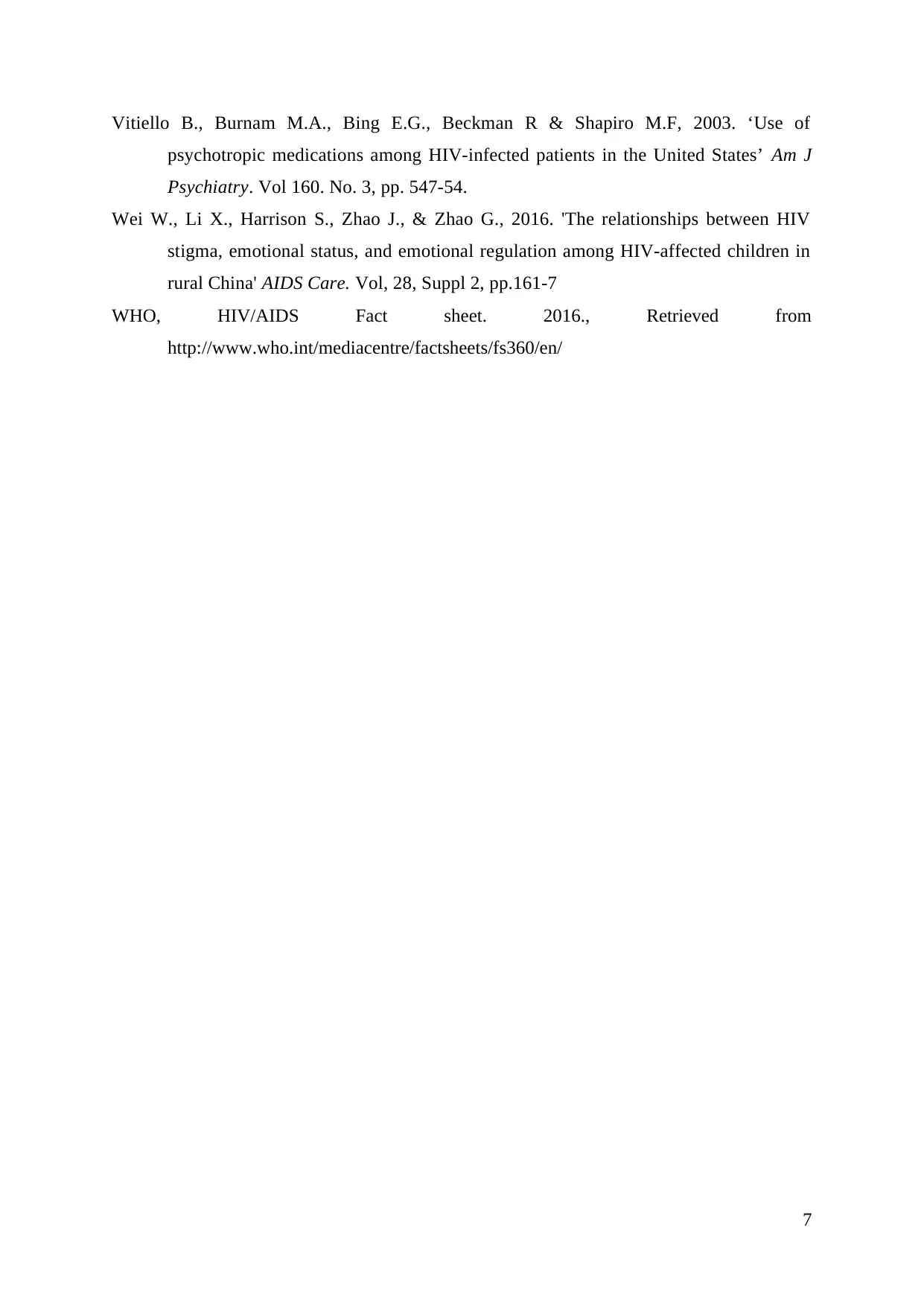
Vitiello B., Burnam M.A., Bing E.G., Beckman R & Shapiro M.F, 2003. ‘Use of
psychotropic medications among HIV-infected patients in the United States’ Am J
Psychiatry. Vol 160. No. 3, pp. 547-54.
Wei W., Li X., Harrison S., Zhao J., & Zhao G., 2016. 'The relationships between HIV
stigma, emotional status, and emotional regulation among HIV-affected children in
rural China' AIDS Care. Vol, 28, Suppl 2, pp.161-7
WHO, HIV/AIDS Fact sheet. 2016., Retrieved from
http://www.who.int/mediacentre/factsheets/fs360/en/
7
psychotropic medications among HIV-infected patients in the United States’ Am J
Psychiatry. Vol 160. No. 3, pp. 547-54.
Wei W., Li X., Harrison S., Zhao J., & Zhao G., 2016. 'The relationships between HIV
stigma, emotional status, and emotional regulation among HIV-affected children in
rural China' AIDS Care. Vol, 28, Suppl 2, pp.161-7
WHO, HIV/AIDS Fact sheet. 2016., Retrieved from
http://www.who.int/mediacentre/factsheets/fs360/en/
7
1 out of 7
Related Documents
Your All-in-One AI-Powered Toolkit for Academic Success.
+13062052269
info@desklib.com
Available 24*7 on WhatsApp / Email
![[object Object]](/_next/static/media/star-bottom.7253800d.svg)
Unlock your academic potential
Copyright © 2020–2026 A2Z Services. All Rights Reserved. Developed and managed by ZUCOL.





